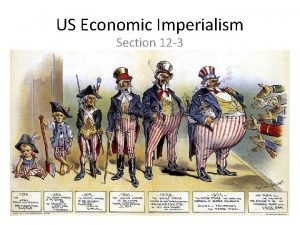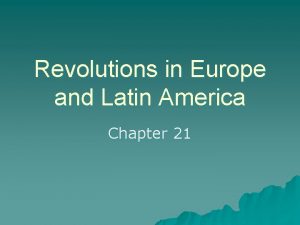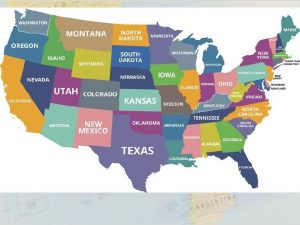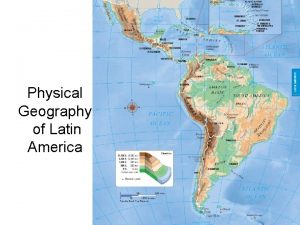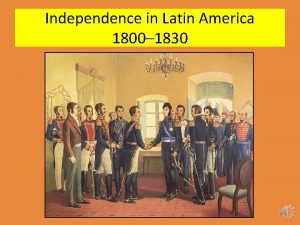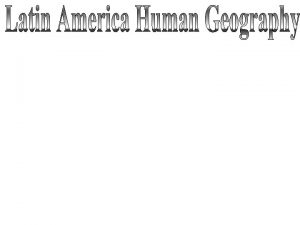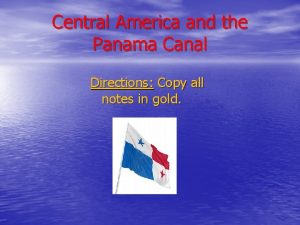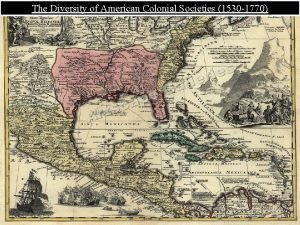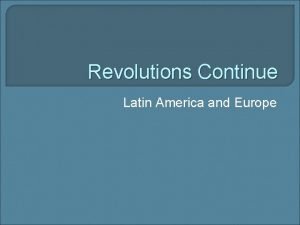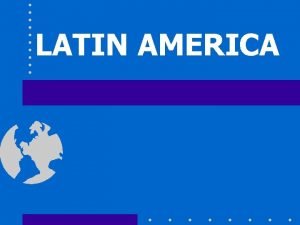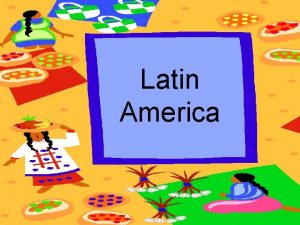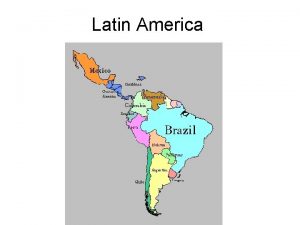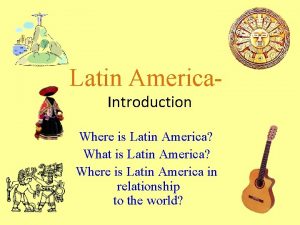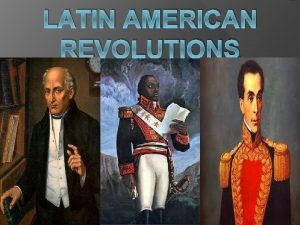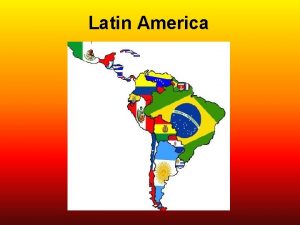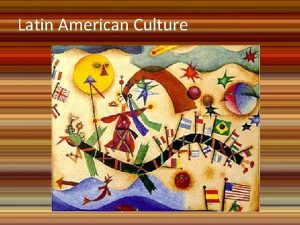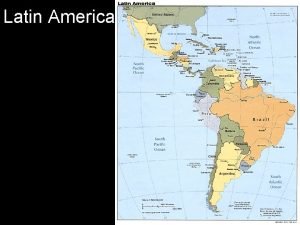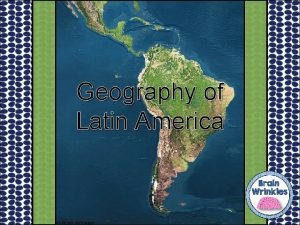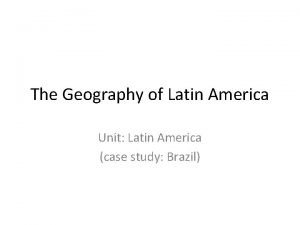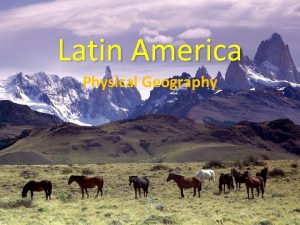LATIN AMERICA Introduction Where is Latin America Find






















- Slides: 22

LATIN AMERICA Introduction

Where is Latin America? • Find Mexico on a World Map. . . …and move southward

Latin America

WHY is it called Latin America? And Spanish • Latin Portuguese is a language just about is spoken everywhere • The two widely spoken in Brazil else!!! languages are Latin-based

What physical characteristics do we need to know? CLIMATE • In Central America and northern South America, it is TROPICAL In northern Mexico and southern South America, it is TEMPERATE

Along with climate, • In the Southern Hemisphere: • Remember that SEASONS are REVERSED: desrever

• When it is winter in the USA. . . …it is summer in South America (and southern Africa & Australia & Antarctica)

Physical Features • Mountains in Latin America: • Sierra Madres split along Mexico’s coasts • Andes along west coast of South America • Just like the west coast of the USA, the Andes mountains are VOLCANIC

Mountains in Latin America can be split into agricultural “zones” as you move higher up the mountain. This is called “vertical zonation” Snow caps Tierra Fria no crops, just grazing Tierra Templada ANDES MOUNTAINS: crops that like nd The longest chain and 2 temperate land highest mountains in the world!! Tierra Caliente crops that like hot temperatures Sierra Madres

Another look at Vertical Zonation in the Andes Mts.

• Along with volcanoes, western But California can handle the earthquakes MUCH and betterparts of South America because of building codes and Central America experience earthquake-proof structures that are built in the states. Unfortunately, Chile, Peru, and other countries in Latin America don’t follow any type of codes and whole duevillages tobuilding the constant motion can be wiped out in an Earth’s tectonic platesearthquake!!! EARTHQUAKES of the Just like in California!!

Greater (Bigger) Antilles More Physical Features: • There are MANY islands in Latin America • The Caribbean Islands are called Lesser (Smaller) Antilles the “West Indies” or the “Greater and Lesser Antilles” • The Caribbean Islands are well known for their agriculture and tourism

• The Galapagos Islands (off the west coast of Ecuador) are known for their Tortoises and other scientific studies of plants and animals. Ga-LAP-ah-goes Islands Does Charles Darwin ring a bell?

• The Falkland Islands are controlled by the United Kingdom • The British defeated the Argentines in “Falkland Islands the Falkland Island War of 1982 (Isla Malvinas) • These islands have a HUGE Administered by military advantage of the location to thebecause UK (claimed the Straitby of Argentina)” Magellan. . . • . . . esp. if the Panama Canal is blocked during wartime

Other Physical Chars. Grasslands: huge, flat plains in Latin America- known for agriculture • The Llanos are in Venezuela; the Gran Chaco are in Paraguay; and the most famous are the Pampas in Argentina

We’re usually found in grassland Or theranches…like Pampas of the Llanos in Venezuela Argentina…. where the best beef cattle in the world is raised!! Latin American Cowboys are called Gauchos Llanos Pampas

Unfortunately, we’re being cut down and set aflame to make room for interior farmland construction!!!! OUCH!!! This is called “Slash and Burn” Agriculture Rainforests: Costa Rica and Brazil~ “Amazonia” is Amazonia (in Brazil) the largest in the world! http: //www. ran. org/info_center/about_rainforests. html

• Coastal Deserts: West Coast of South America ATACAMA DESERT in Chile This clip art is actually “wrong” to use for the Atacama…there are cacti shown!! One of the hottest and driest But why can places be so dry? ? ? places on Earth. 1/16”/yr THIS is more like it!!! The “rain shadow” effect is part of the reason ww. uni-magdeburg. de/ abp/picturegallery. htm

RAIN SHADOW EFFECT Windward side of the mountains Leeward Side or A “protected” side N of the D ES mountains Pacific Ocean http: //www-cs-students. stanford. edu/~amitp/simblob/rain-shadow. png The Andes Mountains create rain shadows on leeward slopes and cause moisture to be blocked. That’s how we see such dry areas in Latin America. The Andes are so high that they block moisture from the ocean and create grasslands and deserts on the other side of the mountains.

Orinoco River Rio Grande I'm the Rio de la Plata. I’m actually not a river, but an estuary… the large water feature where fresh water from a river meets the salt water of the sea. The AMAZON!! The largest river in the world!! Rivers in Latin America Parana River

IMPACTS of Physical Features? : • Location of urbanization? • People settle along coasts • High population growth rate? • YES! Arable land means more food • Large cities are called: MEGACITIES • Sao Paulo Rio Mexico City

And the MOST important factor from Of course!!!! Latin America? ? ? Didn’t YOU think coffee too?
 Why called latin america
Why called latin america America america you mean the world to me
America america you mean the world to me Asia africa europe north america south america
Asia africa europe north america south america Repetition in let america be america again
Repetition in let america be america again Happening body art
Happening body art Peninsulares
Peninsulares South american map
South american map South america literacy rate
South america literacy rate Revolutions in europe and latin america section 1 quiz
Revolutions in europe and latin america section 1 quiz Middle america
Middle america Middle america
Middle america Latin city model
Latin city model Latin america's geography cloze notes 1
Latin america's geography cloze notes 1 Latin america webquest
Latin america webquest Latin america hierarchy
Latin america hierarchy Latin america political and physical map
Latin america political and physical map Largest economy in latin america
Largest economy in latin america Feudal system definition
Feudal system definition Latin america physical features
Latin america physical features Chapter 25 lesson 4 imperialism in latin america
Chapter 25 lesson 4 imperialism in latin america Latin america acrostic poem
Latin america acrostic poem Caste system in latin america
Caste system in latin america Class system in latin america
Class system in latin america






